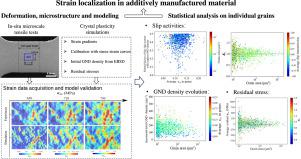当前位置:
X-MOL 学术
›
Int. J. Plasticity
›
论文详情
Our official English website, www.x-mol.net, welcomes your feedback! (Note: you will need to create a separate account there.)
Understanding the strain localization in additively manufactured materials: Micro-scale tensile tests and crystal plasticity modeling
International Journal of Plasticity ( IF 9.4 ) Pub Date : 2024-04-25 , DOI: 10.1016/j.ijplas.2024.103981 Daijun Hu , Zixu Guo , Nicolò Grilli , Aloysius Tay , Zhen Lu , Wentao Yan
International Journal of Plasticity ( IF 9.4 ) Pub Date : 2024-04-25 , DOI: 10.1016/j.ijplas.2024.103981 Daijun Hu , Zixu Guo , Nicolò Grilli , Aloysius Tay , Zhen Lu , Wentao Yan

|
Metallic parts fabricated by additive manufacturing (AM) usually exhibit unique microstructures and non-negligible residual stresses compared with the counterparts produced by conventional manufacturing. These inherent microstructural factors strongly affect the mechanical response of the as-built AM parts. In this study, we focus on the strain localization behavior of 316L stainless steel produced by laser powder-bed-fusion. In-situ tensile tests under a scanning electron microscope are performed, and the digital image correlation method is used to measure the strain distribution combined with electron backscatter diffraction. Meanwhile, a dislocation-based crystal plasticity finite element model incorporating residual stresses is developed to study the origins of the strain localization in the AM material. The results indicate that strain localization in AM materials is closely associated with microstructural features, encompassing behaviors related to slip activities, interactions with neighboring grains and dislocation evolutions. Additionally, the columnar grain features also render the strain distribution sensitive to the loading direction. The strain localization is serious in some small grains with high residual stresses, while in large grains the effect is less significant. These factors collectively contribute to the increasing likelihood of strain localization occurring in the AM microstructures with heterogeneous grain size and texture distribution. This work provides detailed insights into the strain localization in AM materials and would facilitate the manufacturing parameter optimization of AM materials by tuning the microstructure to reduce deformation inhomogeneity.
中文翻译:

了解增材制造材料中的应变局部化:微尺度拉伸测试和晶体塑性建模
与传统制造的金属零件相比,增材制造 (AM) 制造的金属零件通常表现出独特的微观结构和不可忽略的残余应力。这些固有的微观结构因素强烈影响增材制造零件的机械响应。在本研究中,我们重点研究激光粉末床熔合生产的 316L 不锈钢的应变局部化行为。在扫描电子显微镜下进行原位拉伸试验,并采用数字图像相关法结合电子背散射衍射测量应变分布。同时,开发了一种包含残余应力的基于位错的晶体塑性有限元模型,以研究增材制造材料中应变局部化的起源。结果表明,增材制造材料中的应变局部化与微观结构特征密切相关,包括与滑移活动、与邻近晶粒的相互作用以及位错演化相关的行为。此外,柱状晶特征还使得应变分布对载荷方向敏感。在一些残余应力较高的小晶粒中,应变局部化严重,而在大晶粒中,影响不太显着。这些因素共同导致具有异质晶粒尺寸和织构分布的增材制造微结构中发生应变局部化的可能性增加。这项工作提供了对增材制造材料应变局部化的详细见解,并将通过调整微观结构以减少变形不均匀性来促进增材制造材料的制造参数优化。
更新日期:2024-04-25
中文翻译:

了解增材制造材料中的应变局部化:微尺度拉伸测试和晶体塑性建模
与传统制造的金属零件相比,增材制造 (AM) 制造的金属零件通常表现出独特的微观结构和不可忽略的残余应力。这些固有的微观结构因素强烈影响增材制造零件的机械响应。在本研究中,我们重点研究激光粉末床熔合生产的 316L 不锈钢的应变局部化行为。在扫描电子显微镜下进行原位拉伸试验,并采用数字图像相关法结合电子背散射衍射测量应变分布。同时,开发了一种包含残余应力的基于位错的晶体塑性有限元模型,以研究增材制造材料中应变局部化的起源。结果表明,增材制造材料中的应变局部化与微观结构特征密切相关,包括与滑移活动、与邻近晶粒的相互作用以及位错演化相关的行为。此外,柱状晶特征还使得应变分布对载荷方向敏感。在一些残余应力较高的小晶粒中,应变局部化严重,而在大晶粒中,影响不太显着。这些因素共同导致具有异质晶粒尺寸和织构分布的增材制造微结构中发生应变局部化的可能性增加。这项工作提供了对增材制造材料应变局部化的详细见解,并将通过调整微观结构以减少变形不均匀性来促进增材制造材料的制造参数优化。












































 京公网安备 11010802027423号
京公网安备 11010802027423号